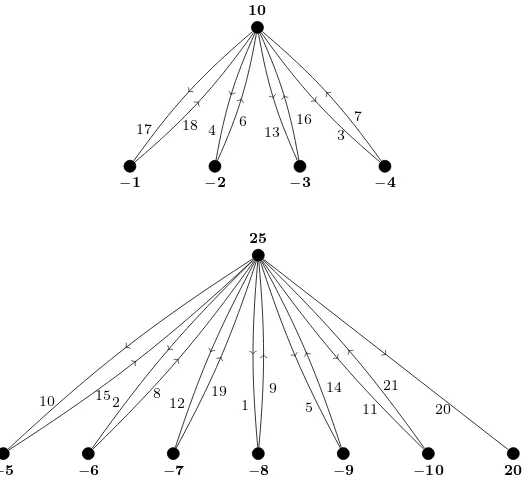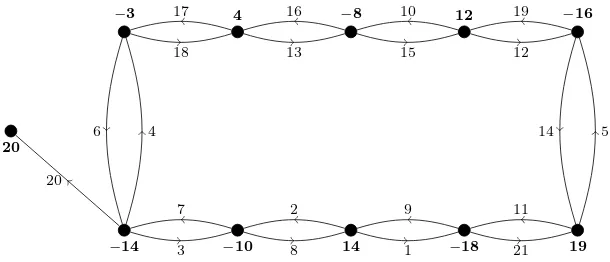Vol. 22, No. 1 (2016), pp. 61–69.
ANTIMAGIC LABELING OF DIGRAPHS
M. Nalliah
School of Advanced Sciences, Department of Mathematics VIT University, Vellore-632 014, INDIA.
Email: nalliahklu@gmail.com
Abstract. An antimagic labeling of a digraphD withpvertices and qarcs is a bijectionffrom the set of all arcs to the set of positive integers{1,2,3, ..., q}such that all theporiented vertex weights are distinct, where an oriented vertex weight is the sum of the labels of all arcs entering that vertex minus the sum of the labels of all arcs leaving it. A digraphD is called antimagic if it admits an antimagic labeling. In this paper we investigate the existence of antimagic labelings of some few families of digraphs using hooked Skolem sequences.
Key words and Phrases: Antimagic labeling, hooked Skolem sequence, symmetric digraph.
Abstrak.Suatu pelabelan antimagic dari sebuah digrafDdenganpbuah titik dan qbuah busur adalah suatu bijeksif dari himpunan semua busur ke himpunan bi-langan bulat positif{1,2,3, ..., q}sedemikian sehingga semua bobot titik berarahp berbeda, dimana suatu bobot titik berarah adalah jumlahan label-label dari semua busur yang menuju titik tersebut dikurangi jumlahan label-label dari semua busur yang keluar dari titik tersebut. Sebuah digrafDdikatakan antimagic jika mempun-yai pelabelan antimagic. Dalam paper ini kami menunjukkan keberadaan pelabelan antimagic dari beberapa keluarga digraf menggunakan barisan Skolem terkait.
Kata kunci: Pelabelan antimagic, barisan Skolem terkait, digraf simetris.
1. Introduction
By graphG= (V, E) we mean a finite, undirected graph with neither loops nor multiple edges. The order and size of Gare denoted bynandm, respectively. For graph theoretical terminology we refer to Chartrand and Lesniak [1].
2000 Mathematics Subject Classification: 05C78.
A digraph D consists of a finite nonempty set V of objects called vertices and a set E of ordered pairs of distinct vertices. Each element of E is an arc or a directed edge. If a digraph D has the property that for each pair u, v of distinct vertices of D, at most one of (u, v) or (v, u) is an arc ofD, then D is an oriented graph. An oriented graph can also be obtained by assigning a direction to (that is, orienting) each edge of a graph G. The digraph D is then referred to as an orientation of G. A digraph H is called a subdigraph of a digraph D if
V(H)⊆V(D) andE(H)⊆E(D).
A digraphDissymmetric if whenever (u, v) is an arc ofD, then (v, u) is an arc ofD as well.
The underlying graph of a digraphD is obtained by removing all directions from the arcs of D and replacing any resulting pair of parallel edges by a single edge. Equivalently, the underlying graph of a digraphD is obtained by replacing each arc (u, v) or a pair (u, v), (v, u) of arcs by the edgeuv. For any graph Gthe digraph obtained by replacing every edgeuv of Gby a pair of symmetric arcsuv
andvu is denoted byS∗ and is called thesymmetric digraphofG.
A labeling of a graphGis a mapping that assigns integers to the vertices or edges or both, subject to certain conditions. The labeling is called a vertex labeling or an edge labeling or a total labeling according to if as the domain of the mapping isV or Eor V ∪E.
D. Hefetz, T. Mutze, and J. Schwartz [3] introduced the concept of antimagic labeling of a digraph.
Anantimagic labelingof a digraphDwithpvertices andqarcs is a bijection from the set of arcs of D to {1,2,3, ..., q} such that allporiented vertex weights are distinct, where an oriented vertex weight is the sum of the labels of all arcs entering that vertex minus the sum of the labels of all arcs leaving it. A digraphD
is calledantimagic if it admits an antimagic labeling. The oriented vertex weight of a vertexv∈V(D) is denoted by w(v). An orientationD of a graphGis called an antimagic orientation if the digraphDis antimagic.
D. Hefetz, T. Mutze, and J. Schwartz [3] proved that, for every orientation of the following undirected graphs, stars Sn on n+ 1 vertices for every n 6= 2,
wheels Wn on n+ 1 vertices for every n ≥ 3 and cliques Kn on n vertices for
every n 6= 3, there exists an antimagic labeling. They also proved that, given
G = (V, E) a (2d+ 1)-regular (not necessarily connected) undirected graph with
d≥0,there exists an antimagic orientation ofG. They posed the following problem and conjecture.
Question 1.1. [3] Is every connected directed graph with at least 4 vertices an-timagic?
Conjecture 1.2. [3] Every connected undirected graph admits an antimagic ori-entation.
They observed that the answer to the Question 1.1 is “no”. Indeed, ifG=
few families of undirected connected graphs, but not for all connected graphs. Therefore, the Conjecture 1.2 is still open.
In this paper we discuss the existence of antimagic labelings for digraphs and we use the concept of hooked Skolem sequence.
Definition 1.3. [2, 4, 5, 6] A hooked Skolem sequence of order n is a sequence
S= (s1, s2, ..., s2n+1) satisfying the following conditions:
(1) For everyt∈ {1,2, ..., n} there exist exactly two elements si, sj ∈S such
that si=sj =t.
(2) Ifsi=sj=t withi < j, thenj−i=t.
(3) s2n= 0.
Hooked Skolem sequence can also be written as a collection of ordered pairs
{(ai, bi); 1 ≤i ≤n, bi−ai =i with S
Theorem 1.4. [2, 4, 5, 6, 7] A hooked Skolem sequence of order n exists if and only ifn≡2 or3(mod 4).
2. Main Results
In this section we prove that some families of digraphs are antimagic, using the concept of hooked Skolem sequences. We use the ordered pair notation for hooked Skolem sequences.
A non symmetric digraph G∗ is obtained from a symmetric digraph S∗ by adding a new vertex vand an arcuvor vu, whereu∈V(S∗).
Example 2.2. Let G = K1,4 ∪K1,6, so that α1 = 4 and α2 = 6. Clearly, α1+α2 ≡2(mod4). A hooked Skolem sequence of order 10 (in ordered pair no-tation) is given byS={(17,18),(4,6),(13,16),(3,7),(10,15),(2,8),(12,19),(1,9),
(5,14),(11,21),(0,20)}. The corresponding antimagic labeling of the symmetric digraphG∗ is given in Figure 1.
10
−1 −2 −3 −4
17 18 4 6 13 16 3
7
25
−5 −6 −7 −8 −9 −10 20
10 152 812 19 1
9 5
14 11
21 20
Figure 1. An antimagic labeling of (K1,4∪K1,6)∗.
Theorem 2.3. Let G = Kr,s be the complete bipartite graph and rs ≡ 2 or
3(mod 4). ThenG∗ is antimagic.
Proof. Let X(G∗) = {u1, u2, . . . , us} and Y(G∗) = {v1, v2, . . . , vs, v} be
the bipartition ofG∗.ThenE(G∗) =
r
S
i=1
{uiv1, uiv2, . . . , uivs} ∪ r
S
i=1
{v1ui, v2ui, . . . ,
vsui} ∪ {urv}. Clearly, q =|E(G)| =rs≡ 2 or 3(mod 4) and |E(G∗)|= 2q+ 1.
Now we definef∗:E(G∗)→ {1,2, . . . ,2q+ 1}by
f∗(u
ivj) = a(i−1)s+j,
f∗(v
jui) = b(i−1)s+j,
f∗(u
sv) = rs.
Since b(i−1)s+j −a(i−1)s+j = (i−1)s+j,1 ≤ i ≤ r and 1 ≤ j ≤ s, it follows
that w(ui) = (i−1)s2+s(s2+1),1 ≤i≤r−1, w(ur) = (r−1)s2+s(s2+1)−2rs,
w(v) = 2rs andw(vj) =−
h
rj+rs(r−1) 2
i
.Clearly, all the oriented vertex weights are distinct and hence,f∗ is an antimagic labeling ofG∗.
Example 2.4. LetG=K2,3. Clearly,q= 6.A hooked Skolem sequence of order 6 (in ordered pair notation) is given by S = {(10,11),(2,4),(6,9),(1,5),(3,8),
(7,13),(0,12)}.The corresponding antimagic labeling of the digraphG∗is given in Figure 2.
6
−5 −7 −9 12
3
10
11 2 4 6
9
1
5 8 3 7
13
12
Figure 2. An antimagic labeling ofK∗ 2,3.
Theorem 2.5. LetG=Cp be the cycle of orderp, wherep≡2or3(mod4).Then
G∗ is antimagic.
Proof.LetV(G∗) ={u
1, u2, . . . , up, v}andE(G∗) ={u1u2, u2u3, . . . , upu1} ∪ {u2u1, u3u2, . . . , u1up} ∪ {upv}. Since q = p ≡ 2 or 3(mod 4), there exists a
where 1≤ai≤2q+ 1,1≤bi≤2q+ 1 andbi−ai =i,1≤i≤q.We consider two
Then
w(ui+1) =
(
4i, if i is odd, 1≤i≤ p+12 −2
−4i, if i is even, 2≤i≤p+12 −2
w(up+1 2 +i) =
−(2p−1), if i = 1
−(2p+ 4−4i), if i is odd, 3≤i≤p+12 −2 2p+ 4−4i, if i is even, 2≤i≤ p+12 −2
w(u1) =−3, w(up) =−(2p+ 6).
Clearly, all the oriented vertex weights are distinct and hence, f∗ is an an-timagic labeling ofG∗.
Example 2.6. LetG=C10 andC11. A hooked Skolem sequence of order 10 (in ordered pair notation) is given byS ={(17,18),(4,6),(13,16),(3,7),(10,15),(2,8),
(12,19),(1,9),(5,14),(11,21),(0,20)}, and a hooked Skolem sequence of order 11 (in order pair notation) is given byS={(3,4),(16,18),(5,8),(15,19),(6,11),(14,20),
(2,9),(13,21),(1,10),(7,17),(12,23),(0,22)}. The corresponding antimagic label-ing of the digraphG∗ is given in Figure 3 and 4, respectively.
−3 4 −8 12 −16
−14 −10 14 −18 19
20
18 17
13 16
15 10
12 19
14 5
11
21 9
1 2
8 7
3 4 6
20
−3 4 −8 12 −16
10 −14 18 −21 20
−28 22
4 3
5 8
11 6
2 9
10 1
12
23 17
7 13
21 20
14 15 19
16 18
22
Figure 4. An antimagic labeling ofC∗ 11.
3. Conclusion and Scope
In this paper we have discussed the existence of antimagic labelings of di-graphs. In particular, if G∗ is a digraph associated with an undirected graph G, we have used the concept of hooked Skolem sequences to prove the existence of antimagic labelings of G∗ for several classes of graphs. This proof technique can be used to prove the existence of antimagic labelings of G∗ for other families of graphs.
Acknowledgement. The author would like to thank the referees for their valuable comments.
REFERENCES
[1] Chartrand, G., and Lesniak, L.,Graphs & Digraphs, Fourth Edition, Chapman & Hall/CRC, 2005.
[2] Colbourn, C.J., and Dinitz, J.H.,Handbook of combinatorial designs, second edition, Chap-man & Hall/ CRC, 2006.
[3] Hefetz, D., Mutze, T., and Schwartz, J., ”On Antimagic Directed Graphs”,J.Graph Theory,
64(2010), 219-232.
[4] Linek, V., and Jiang, Z., Hooked k-extended Skolem sequences,Discrete Math., 196(1-3) (1999), 229-238.
[5] O’Keefe, E.S., ”Verification of a conjecture of Th. Skolem”,Math. Scand.,9(1961), 80-82. [6] Shalaby, N., ”The existence of near-Skolem sequences and hooked near-Skolem sequences”,
Discrete Math.,135(1994), 303-319.



